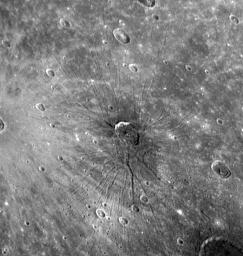"The spider" now has an official name: Pantheon Fossae. As first presented at the NASA press conference on January 30 (see PIA10397), when MESSENGER flew by Mercury on January 14, 2008, the Mercury Dual Imaging System (MDIS) snapped images of an intriguing and previously unknown feature on the surface of Mercury. Near the center of the Caloris basin, a set of troughs (called graben by geologists) was observed to radiate outward in a pattern unlike anything ever seen on Mercury. The Science Team nicknamed this unique feature "the spider." The International Astronomical Union (IAU) recently approved the official name of Pantheon Fossae, as detailed in the MESSENGER press release issued last week.
The word fossa is Latin and means trench. The term is used in planetary geology to name features that are long, narrow, shallow depressions. Fossae, the plural of fossa, have been named on planetary bodies including Mars, Venus, and the Moon, but Pantheon Fossae are the first to be named on Mercury. The name is taken from the Pantheon in Rome, an ancient temple with a classic domed roof. The dome of the Pantheon has a series of sunken panels that radiate from a central circular opening at the top of the dome, and Mercury's Pantheon Fossae is reminiscent of this pattern. Consequently, the crater near the center of Pantheon Fossae is now named Apollodorus, who is credited by some as being the architect of the Pantheon. Apollodorus, shown in the middle of this Narrow Angle Camera (NAC) image, has a diameter of 41 kilometers (25 miles). MESSENGER scientists are debating whether Apollodorus played a role in the formation of Pantheon Fossae or whether the crater is simply from a later impact that occurred close to the center of the radial pattern.
Image Mission Elapsed Time (MET): 108828901
These images are from MESSENGER, a NASA Discovery mission to conduct the first orbital study of the innermost planet, Mercury. For information regarding the use of images, see the MESSENGER image use policy.

 Planetary Data System
Planetary Data System












